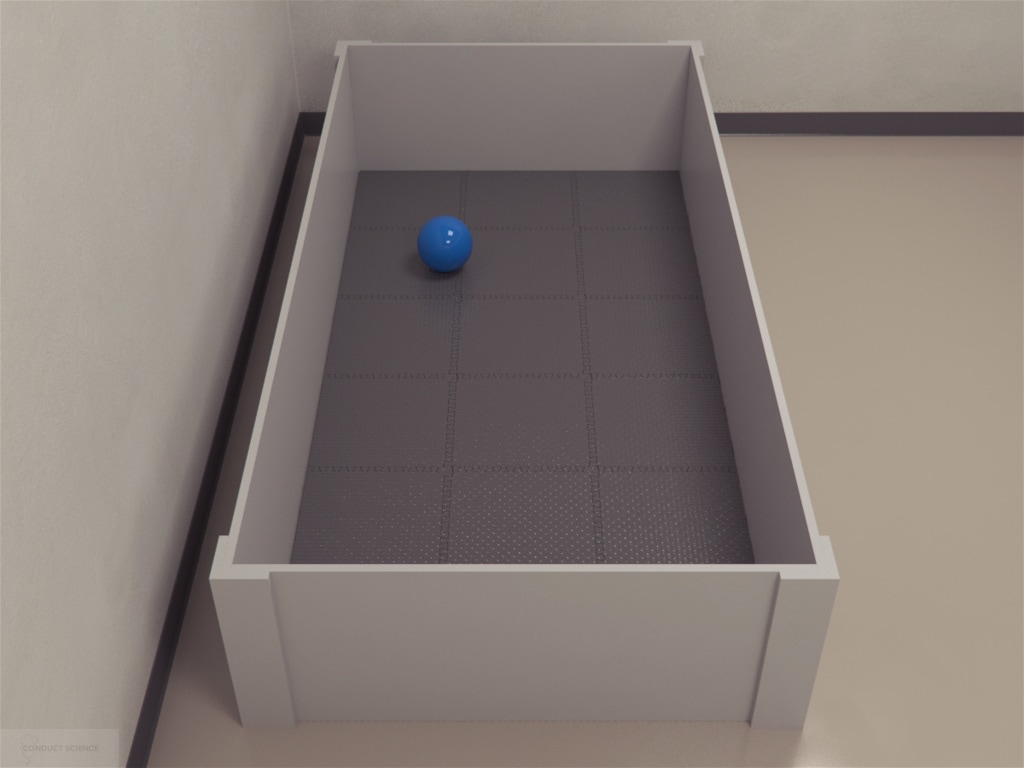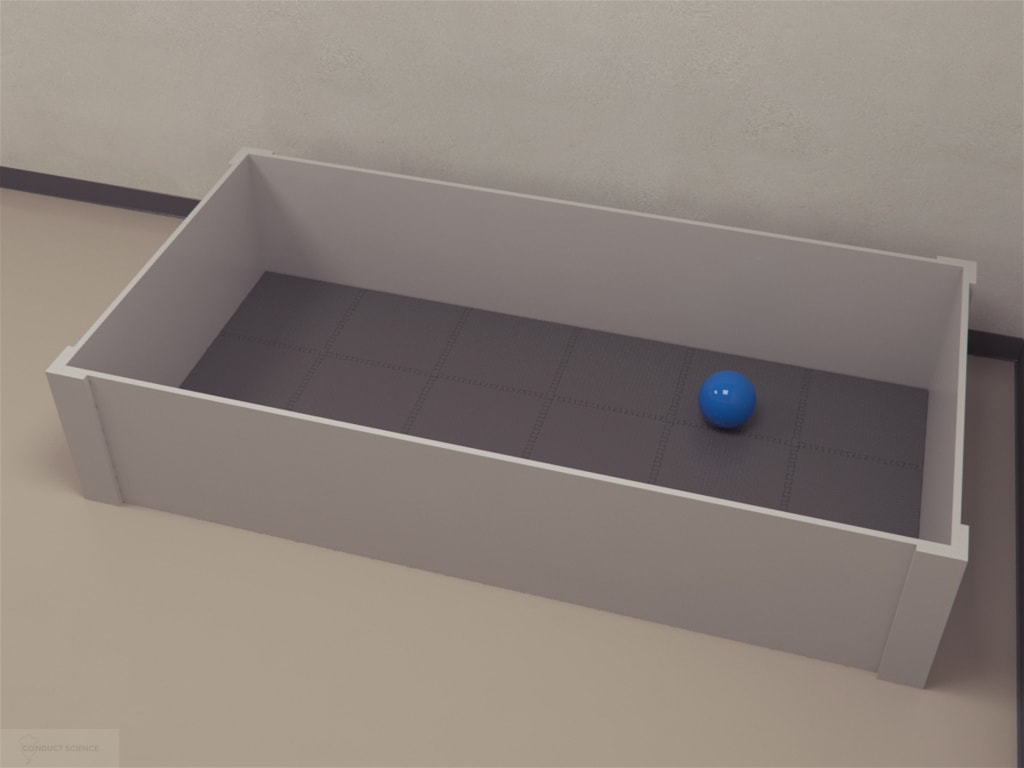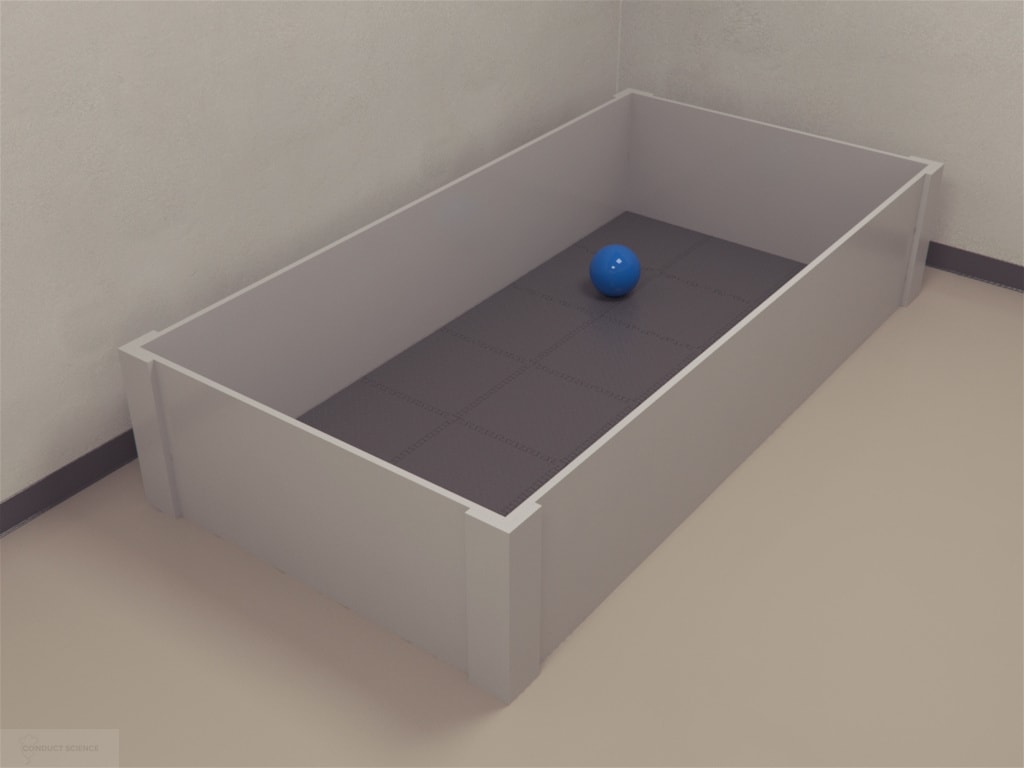Description
Pig are an important tool in the research for TBI given their similarity to humans. Open field behavior to detect a wide spectrum of clinically relevant behaviors in the piglet was first described by Sullivan et al (2013) and relevant behaviors such as sniffing floor, walls, or toy; running, walking, standing still for > 1 sec, lying down, moving the toy, and attempting to escape the test space are assessed.
The field is divided into nine zones and the position of the piglet’s snout within the open field was marked at 2 sec time intervals. The MazeEngineers open field includes a ball and acrylic walls to ensure the pen inside the space (1.2 m · 2.4 m pen) with a single toy (19 cm diameter blue ball).
Price & Dimensions
Pig
$ 2290
Per Month- (1.2 m x 2.4 m pen) with a single toy (19 cm diameter blue ball)
Documentation
Introduction
The pig open field is similar to the rodent open field and allows the subject to explore its surroundings freely to assess the locomotor activity and explorative tendencies of the subjects. The pig open field allows the use of pigs as subjects to assess the effects of traumatic brain injuries that can occur in children as well as assess emotionality in growing pigs. The pig open field allows better assessment of these parameters as the pig brain resembles the human brain more closely than the rodent brain (Sullivan et al., 2013).
Due to the high resemblance of developing porcine brain with the developing human infant brain, studying brain injury in piglets holds significant implications for understanding similar injuries in human children. Basic parameters like movement and interaction with the toy give a good indication regarding the extent and impact of a particular brain injury, even allowing the experimenter to map difference in behaviors in injuries caused in the axial or sagittal planes (Sullivan et al., 2013). When assessing the emotionality of the pigs the aim is to understand how chronic anxiety states are produced in agricultural pigs due to the constant handling and crowded living conditions they are subjected to and how this has implications in their health and welfare (Donald et al., 2011). The open field is a simple apparatus consisting only of an open space bounded by walls and containing an object (e.g., a ball) with which the subjects can interact. This creates the perfect environment to assess the normal behavior of the pigs and compare it to any changes in behavior caused by brain damage or anxiety.
Apparatus & Equipment
The open field measures 1.2 m x 2.4 m and is divided into nine zones. The open field consists of acrylic walls and a blue ball with a diameter of 19 cm.
Training Protocol
Pigs Open Field Performance With & Without Azaperone
Two tests are performed on each piglet, three days apart. In the first test the subject is injected with 1mg/kg of Azaperone and in the second test the subject is given an equivalent volume of normal saline. In both tests the subjects are exposed to the open field for 10 minutes and their behavior is observed. In the first test the subjects are divided into two groups. The first group’s behavior is observed immediately after receiving the injection, whereas the second group’s behavior is observed 20 minutes after receiving the injection. (Donald et al., 2011)
Pigs Open Field Performance With & Without Companion
Half of the subjects are tested alone while the other half are tested with the companions. The companions chosen for the subjects are those with which the subject being tested shared a pen house. The behavior of the companion is not observed. The companion pigs are given two 15 minutes long exposure to the open field one or two days prior to the experiment. The companions are only used once and are placed in the open field before the subject. (Donald et al., 2011)
Visiting Pig’s Open Field Twice
Three or four subjects are taken from each litter and were tested twice over two consecutive days. (Donald et al., 2011)
Data Analysis
Data Analysis
The following parameters are recorded to carry out data analyses:
- Time spent by subject dwelling in the same zone
- Time spent standing still
- Time spent walking
- How much of the open field test space was utilized – with a higher value being allotted to uniform exploration of all zones of the open field
- Measuring the complexity of the subject’s movement between zones – which zones were explored in what order
- Time spent sniffing the toy
- Time spent moving the toy
Strengths & Limitations
Strengths
Pig brains are similar to human brains which makes conducting these experiments more fruitful in terms of practical human implications. Using different parameters to assess the emotionality of the pigs gives more accurate results as opposed to using only one parameter. The use of zones allows better and more detailed assessment of the movement of the pigs.
Limitations
There is a possibility that the stress of being in a new environment could reduce the desire to explore the open field which can affect the result of the experiment testing brain injury but proves to be beneficial when testing the effectiveness of anti-anxiety drugs. There is only a limited time interval (four days) given to the study of the effect of brain injuries which does not count for long-term effects of these injuries. Furthermore, repeated testing can lead to habituation and disrupt the accuracy of the results for both the brain injury and emotionality experiments.
Summary & Key Points
- The open field presents an open novel space for pigs to explore and allows for the assessment of their locomotion and behavior.
- The pig brain resembles the human brain much more closely than the rodent brain which makes these experiments more fruitful.
- The open field can be used to assess brain injuries in children and can also be used to assess emotionality.
References
- The open field presents an open novel space for pigs to explore and allows for the assessment of their locomotion and behavior.
- The pig brain resembles the human brain much more closely than the rodent brain which makes these experiments more fruitful.
- The open field can be used to assess brain injuries in children and can also be used to assess emotionality.



